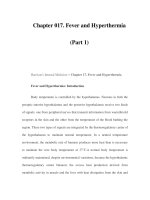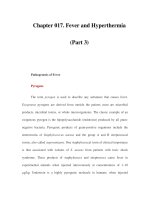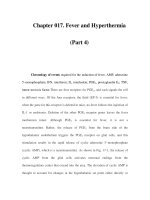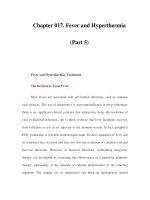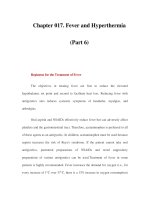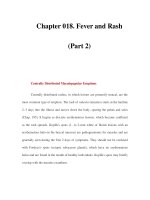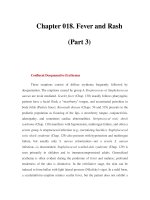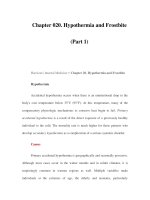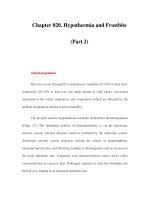Chapter 017. Fever and Hyperthermia (Part 3) pot
Bạn đang xem bản rút gọn của tài liệu. Xem và tải ngay bản đầy đủ của tài liệu tại đây (87.84 KB, 5 trang )
Chapter 017. Fever and Hyperthermia
(Part 3)
Pathogenesis of Fever
Pyrogens
The term pyrogen is used to describe any substance that causes fever.
Exogenous pyrogens are derived from outside the patient; most are microbial
products, microbial toxins, or whole microorganisms. The classic example of an
exogenous pyrogen is the lipopolysaccharide (endotoxin) produced by all gram-
negative bacteria. Pyrogenic products of gram-positive organisms include the
enterotoxins of Staphylococcus aureus and the group A and B streptococcal
toxins, also called superantigens. One staphylococcal toxin of clinical importance
is that associated with isolates of S. aureus from patients with toxic shock
syndrome. These products of staphylococci and streptococci cause fever in
experimental animals when injected intravenously at concentrations of 1–10
µg/kg. Endotoxin is a highly pyrogenic molecule in humans: when injected
intravenously into volunteers, a dose of 2–3 ng/kg produces fever, leukocytosis,
acute-phase proteins, and generalized symptoms of malaise.
Pyrogenic Cytokines
Cytokines are small proteins (molecular mass, 10,000–20,000 Da) that
regulate immune, inflammatory, and hematopoietic processes. For example, the
elevated leukocytosis seen in several infections with an absolute neutrophilia is the
result of the cytokines interleukin (IL) 1 and IL-6. Some cytokines also cause
fever; formerly referred to as endogenous pyrogens, they are now called pyrogenic
cytokines.
The pyrogenic cytokines include IL-1, IL-6, tumor necrosis factor (TNF),
ciliary neurotropic factor (CNTF), and interferon (IFN) α. (IL-18, a member of the
IL-1 family, does not appear to be a pyrogenic cytokine.) Other pyrogenic
cytokines probably exist.
Each cytokine is encoded by a separate gene, and each pyrogenic cytokine
has been shown to cause fever in laboratory animals and in humans. When
injected into humans, IL-1 and TNF produce fever at low doses (10–100 ng/kg); in
contrast, for IL 6, a dose of 1–10 µg/kg is required for fever production.
A wide spectrum of bacterial and fungal products induce the synthesis and
release of pyrogenic cytokines, as do viruses. However, fever can be a
manifestation of disease in the absence of microbial infection. For example,
inflammatory processes, trauma, tissue necrosis, or antigen-antibody complexes
can induce the production of IL-1, TNF, and/or IL-6, which—individually or in
combination—trigger the hypothalamus to raise the set point to febrile levels.
Elevation of the Hypothalamic Set Point by Cytokines
During fever, levels of prostaglandin E
2
(PGE
2
) are elevated in
hypothalamic tissue and the third cerebral ventricle. The concentrations of PGE
2
are highest near the circumventricular vascular organs (organum vasculosum of
lamina terminalis)—networks of enlarged capillaries surrounding the
hypothalamic regulatory centers.
Destruction of these organs reduces the ability of pyrogens to produce
fever. Most studies in animals have failed to show, however, that pyrogenic
cytokines pass from the circulation into the brain itself. Thus, it appears that both
exogenous and endogenous pyrogens interact with the endothelium of these
capillaries and that this interaction is the first step in initiating fever—i.e., in
raising the set point to febrile levels.
The key events in the production of fever are illustrated in Fig. 17-1. As has
been mentioned, several cell types can produce pyrogenic cytokines. Pyrogenic
cytokines such as IL-1, IL-6, and TNF are released from the cells and enter the
systemic circulation. Although the systemic effects of these circulating cytokines
lead to fever by inducing the synthesis of PGE
2
, they also induce PGE
2
in
peripheral tissues.
The increase in PGE
2
in the periphery accounts for the nonspecific
myalgias and arthralgias that often accompany fever. It is thought that some
systemic PGE
2
escapes destruction by the lung and gains access to the
hypothalamus via the internal carotid. However, it is the elevation of PGE
2
in the
brain that starts the process of raising the hypothalamic set point for core
temperature.
Figure 17-1
